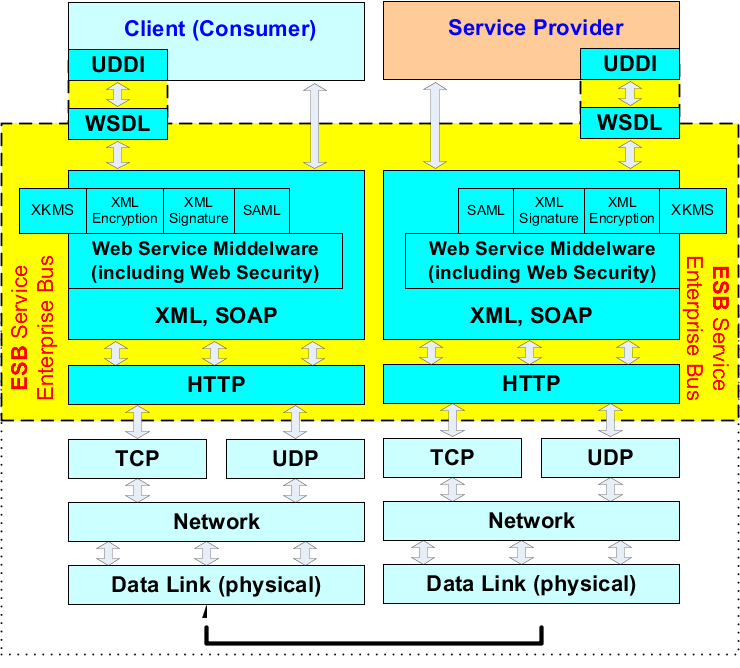D.4. Enterprise Service Bus / Messaging System Profile
455. An Enterprise Messaging System (EMS) is a set of published Enterprise-wide standards that allows sending of semantically precise messages between computer systems. EMS systems promote loosely coupled architectures that allow changes in the formats of messages to have minimum impact on message subscribers. EMS systems are facilitated by the use of XML messaging, SOAP and Web services.
456. An Enterprise Service Bus (ESB) generally provides an abstraction layer on top of an implementation of an enterprise messaging system, which allows integration architects to exploit the value of messaging without writing code. Contrary to the more classical enterprise application integration (EAI) approach of a monolithic stack in a hub and spoke architecture, the foundation of an enterprise service bus is built of base functions broken up into their constituent parts, with distributed deployment where needed, working in harmony as necessary.
457. The following figure shows a layer model for the "Enterprise Messaging System (EMS) / Enterprise Service Bus (ESB)" based on the chapter: "Web Service Fundamentals".

Figure D.20. ESB / EMS Layer Model
458. Based on the Standards (signed in an ESB / EMS Profile) every Client and Server can be integrated into the ESB system.
459. WS-I Basic Profilee
460. The WS-I Basic Profile V1.0 specifies a set of usage scenarios and Web services standards that can be used to integrate systems. It focuses on the core foundation technologies upon which Web services are based. Basic Profile V1.0 was approved unanimously on July 22, 2003, by the WS-I board of directors and members.
461. The WS-I Basic Profile V1.0 – Profile Specification consists of the following non-proprietary Web services related specifications:
-
SOAP V1.1
-
WSDL V1.1
-
UDDI V2.0
-
XML V1.0 (Second Edition)
-
XML Schema Part 1: Structures
-
XML Schema Part 2: Datatypes
-
RFC2246: The Transport Layer Security Protocol Version V1.0
-
RFC2459: Internet X.509 Public Key Infrastructure Certificate and CRL Profile
-
RFC2616: HyperText Transfer Protocol V1.1
-
RFC2818: HTTP over TLS
-
RFC2965: HTTP State Management Mechanism
-
The Secure Sockets Layer Protocol Version V3.0
462. UPDATE: A combined claim of conformance to the WS-I Basic Profile 1.1 and the Simple SOAP Binding Profile 1.0 is roughly equivalent to a claim of conformance to the WS-I Basic Profile 1.0 plus published errata.
463. Additional there are many successful implementations of the basic Web services standards, particularly SOAP and WSDL but many aspects of service interaction and integration are not directly supported by those basic standards, such as security, transactional, delivery assurance, and process modelling – for example WS-Security, WS-Trust, WS-Privacy, and WS-Policy. It also accommodated existing security technologies such as Kerberos, XML Digital Signatures, and XML Encryption.
464. Because of this an "ESB / EMS Profile" proposal is defined on the next page.
465. ESB / EMS Profile proposal:
466. A proposal for an ESB / EMS Profile could be based on the WS-I profiles:
-
WS-I Web Service Basic Profile, v1.1:2nd ed. 2006
-
WS-I Simple SOAP Binding Profile v1.0:2004
467. With the following parts of the WS-I profiles:
-
Simple Object Access Protocol (SOAP) 1.1
-
RFC2616: Hypertext Transfer Protocol – HTTP/1.1
-
RFC2965: HTTP State Management Mechanism
-
Extensible Markup Language (XML) 1.0 (Second Edition)
-
Namespaces in XML 1.0
-
XML Schema Part 1: Structures
-
XML Schema Part 2: Datatypes
-
Web Services Description Language (WSDL) 1.1
-
UDDI Version 2.04 API Specification, Dated 19 July 2002
-
UDDI Version 2.03 Data Structure Reference, Dated 19 July 2002
-
UDDI Version 2 XML Schema
-
RFC2818: HTTP Over TLS
-
RFC2246: The TLS Protocol Version 1.0
-
The SSL Protocol Version 3.0
-
RFC2459: Internet X.509 Public Key Infrastructure Certificate and CRL Profile
468. And with the following additional parts included in the ADaP-34 NISP-Vol2-v2 Draft, but not in the WS-I profiles:
-
TCP (IETF STD 7:1981, RFC0793:1981 updated by RFC3168:2001)
-
UDP (IETF STD 6:1980, RFC0768:1980)
469. And with the following additional parts (not in the WS-I profiles and not in the ADaP-34 NISP-Vol2-v2 Draft):
-
XML Encryption Syntax and Processing (W3C Recommendation 10 December 2002)
-
XML Signature Syntax and Processing Second Edition (W3C Recommendation 10 June 2008)
-
Security Assertion Markup Language, SAML v1.1 (OASIS)
-
XKMS: XML Key Management Specification (W3C Note 30 March 2001)
-
XACML eXtensible Access Control Markup Language Version 2.0 (OASIS Standard, 1 Feb 2005)